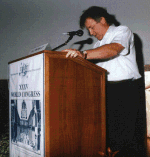 AN ANALYSIS OF LSD IN URINE UNDER VARIOUS STORAGE CONDITIONS
AN ANALYSIS OF LSD IN URINE UNDER VARIOUS STORAGE CONDITIONS
McNally A.J., Li Z., Pilcher I., Salamone S.J.
Roche Diagnostic Systems, Inc., 1080 US Highway 202, Somerville, NJ 08876, USA
Few formal studies have been conducted on the stability of LSD in urine under various storage conditions. A controlled study was undertaken to determine the stability of LSD in pooled urine samples at 0.5 ng/mL and 500 ng/mL of LSD. The concentrations of LSD in urine samples were followed over time at various temperatures, in different types of storage containers, at various exposures to different wavelengths of light, and at varying pHs. LSD concentrations were measured quantitatively by the Abuscreen RIA and by HPLC using a fluorescence detection method. Good correlation of data was observed between the immunoassay binding and the fluorescent integrity of the LSD molecule. Thermostability studies were conducted in the dark in amber glass and polyethylene containers and demonstrated no significant loss at 25° C for four weeks. At higher temperatures there was a 30% loss at 37° C and up to a 40% loss at 45° C for four weeks. These thermostability results were the same for each of the container materials tested.
Three container types, amber glass, polyethylene, and quartz, were used as storage containers for testing the stability of LSD during light exposure. Various light conditions used were: 15 watts of fluorescence light at 15 cm or 200 cm distance, 254 nm UV light with 345 watts, and 365 nm light with 345 watts. All light exposure studies were conducted at various time points at 25° C. The urine containing LSD in the amber glass showed no loss under any light conditions. The polyethylene container after one month revealed a 20% loss when placed 200 cm from the fluorescence source (normal lab conditions) and displayed a 60% loss when placed 15 cm from the fluorescence source. In addition, when using the polyethylene container at a distance of 15 cm from a 254 nm strong UV light source, no loss was observed after eight hours. When this polyethylene container was placed 15 cm from a 365 nm strong light source for eight hours, a 50% loss was observed. In the quartz container, losses of 28% and 50% were observed usig strong light sources of 254 nm and 365 nm respectively, at a 15 cm distance for eight hours.
This study demonstrates the importance of proper storage conditions of LSD in urine in order to insure proper analytical testing results over time.
|